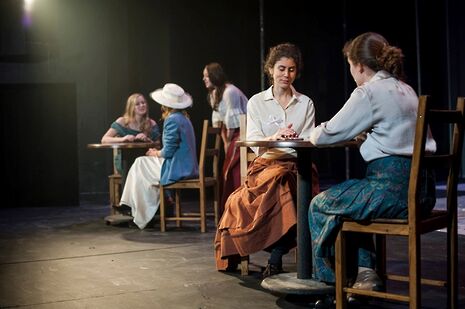Theatre: Her Naked Skin
Lucy Twisleton thinks this play pulls off its challenging storyline incredibly well

Staging a play with subject matter centred on lesbian suffragettes was always going to be challenging, but Her Naked Skin skilfully maintains a balance between private and public storylines, and avoids stereotypes through subtle plot nuances. It is brilliantly staged, showing the rarely seen human side of the suffragette movement, along with the grim reality of class and gender relations in Edwardian England, too often seen from a rose-tinted perspective.
The play traces the struggles of the movement by following the fates of two very different women: Eve Douglas, a working class seamstress new to the movement, and Lady Celia Cain an experienced upper class suffragette in a loveless marriage. The characters could easily have been reduced to mere caricatural militants, fighting sarcastic and uncaring politicians, but this is not the case. A brilliantly nuanced performance is given by Claudia Grigg-Edo (Eve) as a lonely and nervous suffragette trying to cope with a world harsh at every turn. Bea Svistunenko gives a likeable portrayal of the brazen, fickle, passionate Lady Celia. The standout act however, coalescing impeccably with others, is given by Yasmin Freeman as the senior militant suffragette Florence Boorman – her stoic and inspirational performance subtly and cleverly builds up audience empathy.
The powerful running themes of oppression and cruelty are explicitly emphasised in harrowing scenes of force-feeding, attempted suicide and heart-wrenching torture. The slow erosion of mental and physical strength that results from these apparently normal practices exposes the human reality behind the well-known occurrences.While Aoife Kennan’s sympathetic performance as Celia’s husband, Lord Cain, demonstrates a less overt and more thought-provoking dissection of male opposition to the suffragette movement, humorous relief is generously provided by the hilariously grumpy prison warden Mrs Briggs (Rosanna Suppa), causing uproar in the audience.
The transitions between scenes are effortless and allow all parts of the story to create an overall picture of society’s control over women and of the politics of class. Newspapers feature heavily in the staging, both as props and as part of the set, portraying the suffrage struggle as a fight against the condescension of a incredibly biased media. This struggle is compounded by ingenious use of the stage as a prison – although no bars or cages are present on the stage, lonely chairs and narrow spotlights give a feeling of cramped isolation without the need for iron walls.
The great success of the play is that director Rose Reade puts well-played women at the forefront of the story and explicitly allows their private and often bleak solitary struggles to take centre stage, exposing what lay behind sensationalist headlines. Both facets of the plot – a love affair between the suffragettes and their intermittent imprisonment – act to precipitate the mental disintegration of both characters, while gripping the audience with empathy, emphasised by the brief hilarity provided by supporting characters.
While being admittedly harrowing in parts and sometimes uncomfortably realistic, the play also uses these characteristics to its advantage. Performances, staging, costume and directing all work in harmony to provide a compelling and convincing untold story behind the history of the suffrage movement.
 News / Copycat don caught again19 April 2024
News / Copycat don caught again19 April 2024 News / Police to stop searching for stolen Fitzwilliam jade17 April 2024
News / Police to stop searching for stolen Fitzwilliam jade17 April 2024 News / Emmanuel College cuts ties with ‘race-realist’ fellow19 April 2024
News / Emmanuel College cuts ties with ‘race-realist’ fellow19 April 2024 Theatre / The closest Cambridge comes to a Drama degree 19 April 2024
Theatre / The closest Cambridge comes to a Drama degree 19 April 2024 News / Acting vice-chancellor paid £234,000 for nine month stint19 April 2024
News / Acting vice-chancellor paid £234,000 for nine month stint19 April 2024




